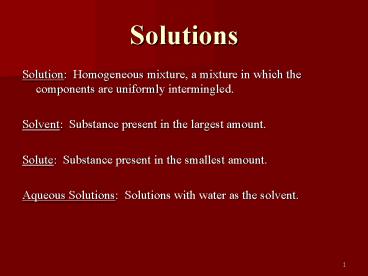Solutions PowerPoint PPT Presentation
1 / 17
Title: Solutions
1
Solutions
- Solution Homogeneous mixture, a mixture in
which the components are uniformly intermingled. - Solvent Substance present in the largest
amount. - Solute Substance present in the smallest
amount. - Aqueous Solutions Solutions with water as the
solvent.
2
Solubility
- What happens when you dissolve NaCl in water?
- When an ionic substance dissolves in water, it
breaks up into individual cations and anions
where are dispersed in water. There are strong
water ions interactions when the solid dissolves.
3
Solubility
- Water also dissolves many nonionic substances.
Sugar and ethanol dissolves in water. Both
contain polar O-H groups. These H-Bond to water
molecules.
4
Solubility
- Oil and water do not mix. Oil is nonpolar and
water is polar. Oil floats on the surface of
water because its density is less than that of
water.
5
Solution CompositionAn Introduction
- Saturated Solution A solution that contains as
much solute as will dissolve at a given
temperature. - Unsaturated Solution A solution that has not
reached the limit of solute that will dissolve. - Concentrated Solution A solution that has a
relatively large amount of solute dissolved. - Dilute Solution A solution that has a
relatively small amount of solute dissolved.
6
Making supersaturated solns
- Make sat. soln
- Cool it slowly and carefully
- Lower temperatures reduced the rate of
crystallization - Once disturbed (energy in), causes
crystallization to occur ? excess crystallized
out of soln - Exothermic
- Heat packs of sodium acetate (can reach 50C!)
- http//www.npr.org/programs/wesun/features/2001/de
c/heatpack/011229.heatpack.html - Lets talk about enthalpy of crystallization in
lab 2
7
- Drinks carbonated under high pressure
- Above 90 atmospheres
- So under CO2 atmosphere
- Once bottle opened, partial pressure of gas above
soda plummets - CO2 solubility decreases drastically
- Gas bubbles out of solution
8
The bends
- Deeper diving has higher pressures
- Must use breathing tank
- If it contains N2 then higher pressure forces N2
to dissolve in higher amounts in blood - If ascension too fast, lower pressure causes N2
to start bubbling out of blood too quickly ?
rupturing of arteries ? excruciatingly painful
death - Must be rushed to hyperbaric chamber
9
Antifreeze
- Lowers freezing pt
- Increases boiling pt
- Reduces risk of radiator boiling over
- Appreciated during the summer months in the
desert - Propylene glycol replacing ethylene glycol
10
Colloids
- From Greek glue
- Btwn suspensions (fine sand in water, mixed up)
solns - 1) Have very high molar masses
- 2) Have large sizes starch, for ex.
- 3) Tyndall effect ? scatter a beam of light
- 4) Do not settle out like suspensions
- 5) Not the same as hemorrhoids
11
Emulsions
- Colloidal dispersions of one liquid in another
- Mayo, milk
- Liquids of different polarities are immiscible
- Need emulsifying agent
- Such as soap (one polar end, one non) proteins
() - In food items ? soy lecithin
- In the world of cleaning ? surfacants (soaps,
etc.)
12
Surfacants
- NaOH animal or veggie fat ? Na fatty acid-
- The fatty acid has a long non-polar tail and a
very polar carboxylate group - Can be used to take away (clean) non-polar
entities like oil, dirt - Surfacants (soap) used in cleaning detergent
13
Detergents
- Lowers surface tension of water (disrupts
H-bonding) - Enhances action of detergent
- Lets watch the following video
- http//www.ilpi.com/genchem/demo/tension/demo
- Sodium lauryl sulfate (soaps, shampoos)
14
Solution CompositionMass Percent
- Mass Percent or weight percent describes a
solutions composition. - The equation for Mass Percent is given below.
- Mass Percent mass of
solute x 100 -
mass of solution - Mass Percent grams of solute
x 100 - grams of solute
grams of solvent
15
Solution CompositionMass Percent
- Example
- A 135 g sample is evaporated to dryness, leaving
4.73 g of solid residue. Calculate the mass
percent of solute present.
16
Solution Composition Molarity
- Molarity Number of moles of solute per volume
of solution in liters. - Example A solution that is 1.0 M contains 1.0
mol per 1 L of solution. - The equation for Molarity is given below.
- M Molarity
moles of solute mol -
liters of solution L
17
Solution Composition Molarity
- Standard Solution Solution whose concentration
is accurately known. - Stock Solution Solutions that are routinely
used and purchased or prepared in concentrated
form. - Dilution The process of adding more solvent to
a solution. Only water is added in a dilution.

